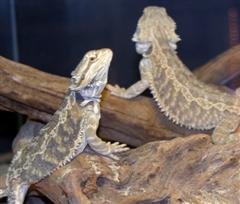Basilisk - Brown
Scientific Name: Basiliscus basiliscus
Mon, 28th April, 2025 - 9:26 am GMT
Sponsor Ads:

Alternative Name
Scientific Name: Basiliscus basiliscusBasic Info
Male Brown Basilisks can reach 32 inches in length and females are somewhat smaller. Their three crests are on the head, along the body and along the tail. They usually appear in brown or olive brown with black stripes. The stripes are usually only on the flanks and on the dorsal crest. They also have a white stripe, which extends from the eyes to the rear legs. The males have a larger crest than the females.
Health
Specific Care Information: Relative Care Ease: Average An adult Brown Basilisk should be housed in a terrarium of at least 55 gallons. The basilisk needs to have access to fresh water at all times. The water bowl should be relatively heavy to ensure that the lizard cannot tip it over. The Brown Basilisk is primarily arboreal and so needs plenty of climbing facilities. They should also be given a basking area with rocks. Basilisks will appreciate plants, either natural or artificial, to hide in. The plants will also help maintain the high humidity necessary for the basilisk. The temperature in the vivarium should be about 85 degrees Fahrenheit during the day and about 75 degrees at night. Brown Basilisks enjoy basking and should be provided with a basking area in the low to mid 90s.Habitat
Found in Panama, northwestern Columbia, and Costa RicaBehavior
The Brown Basilisk is native to Central America, and like other basilisks, it is able to run on water, earning it the name "Jesus Lizard." While legends speak of basilisks as being able to turn anyone to stone with a glance, the real basilisk is far more innocuous, however, they are still interesting animals. They are able swimmers and use their swimming and water-walking abilities to escape predators. They come from a warm environment and prefer temperatures of between 84 and 88 degrees Fahrenheit. They are omnivorous and feed on a mixture of live food, such as insects and small rodents, as well as on vegetables and other plant life. The Brown Basilisk lives in forests, near water. They enjoy basking in the sun and will climb trees and rocks to do so. Basilisks are able to "walk on water" because during their movement on the water they create air pockets and it is theorized that these air pockets help support the basilisk. These "air pockets" are actually slight cushions of air that form between the feet and the water and aid in preventing the feet from penetrating the surface of the water. Additionally, the angle in which the foot strikes the water aids in not only propelling the basilisk forward but upward as well. The combination of foot angle on the water, speed of the stride, and water surface tension allow this unique behavior.Origin
Central AmericaHistory
Native to Central America, the Brown basilisk can be found in Panama, northwestern Columbia, and Costa Rica.Common Foods
Brown Basilisk will do well on a mixture of 60% live food and 40% vegetable matter. The live foods can be in the form of crickets, waxworms, mealworms and pinky mice. Crickets should be the most abundant insect offered because they are the most nutritiouSponsor Ads:
You know you are in trouble when your only son tells you he wishes Anita Bryant would mind her own business. -- Unknown
Basilisk - Brown
Coded by: BGID® | ALL RIGHTS RESERVED Copyright © 2000-2025
Disclaimer | Privacy | Report Errors / Contact | Credits










